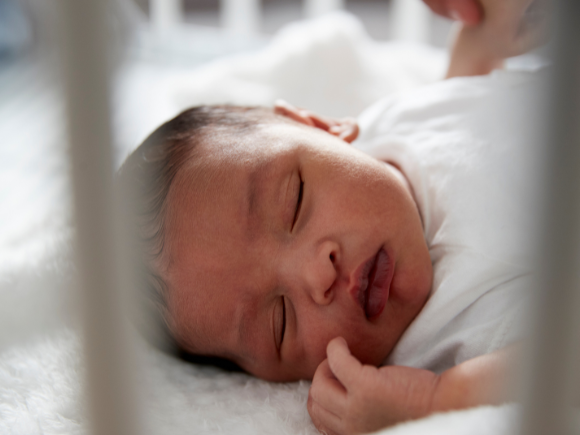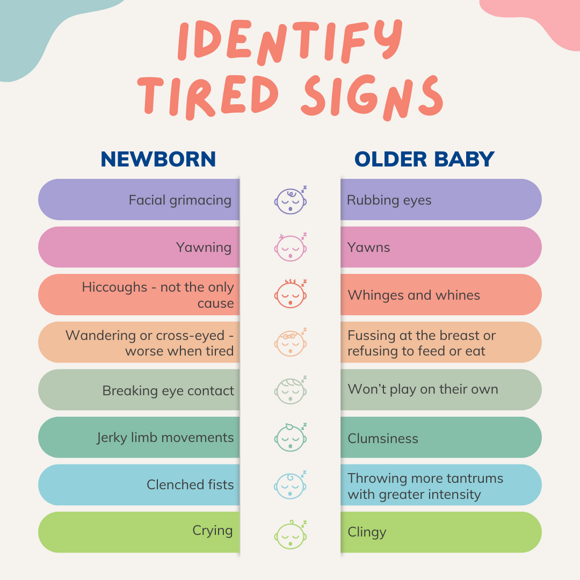
Newborn Sleep Patterns
Sleep is individual and is dependent on physical activity, general health and wellbeing and environmental factors. Therefore, the required amount of sleep may vary from baby to baby and sleep to sleep. Be guided by your newborn’s tired signs and behaviour.
Sleep occurs in cycles containing active (light sleep) and passive (deep sleep) phases. Your baby may be grizzly or may also fidget as they go between the sleep cycles. Most newborns may wake up for a short duration and they may need encouragement to help get back to sleep and stay asleep. These are not baby sleep problems – they are normal. When your baby doesn’t get enough sleep, life can be challenging.
Why is sleep important for newborns?
The importance of sleep for your growing baby can not be overstated enough. Unlike adults, newborns have a lot more growth and development happening every day and need more sleep to conserve energy to allow for this.
Sleep helps newborns grow.
Sleep is essential for a baby’s growth. When your newborn is asleep, their brain releases human growth hormones (HGH) which supports their height, muscle mass, and bone density. Adequate sleep helps regulate feeding cycles and supports healthy weight gain. Additionally, sleep is essential for restoring energy levels and promoting overall well-being. Establishing consistent sleep routines and ensuring sufficient sleep duration is vital for your baby's optimal growth and development.
A newborn’s sleep helps keep their immune system strong.
A baby’s immune system helps them fight off infections and illnesses. Throughout their life - as a baby, toddler, teenager, and adult adequate sleep is essential for not only their physical and emotional wellbeing, it will also support their immune system health.
A newborn’s sleep aids their motor development.
You may be surprised to know that when your newborn twitches and jerks in their sleep, their brain is teaching them motor skills!
Sleep keeps a baby’s emotions stable.
A tired baby is often a fussy and irritated baby. This is because sleep helps the brain, including the parts of the brain that affect a child’s emotions, to function properly.
Newborn Sleep Cycles
Newborn sleep occurs in cycles of two phases – light or REM phase (the rapid eye movement phase) and the deep phase.
The light phase is when your baby first falls asleep, and it can last a period of 10 to 20 minutes. During this time you may notice body movements, muscle twitches, and dreaming. This is not a sleep problem – it is normal active sleep.
- The deep phase is quiet, deep and restful. It’s believed that this deep sleep is when your baby heals and grows. The depth of this sleep is important and may impact on whether your baby continues to sleep well and how they react when they’re awake – happy or crying. Newborn sleep is different to adult sleep as your baby’s brain is still developing.
How long are newborn sleep cycles?
Sleep cycles are significant and do change continually for each age group. These changes and sleep patterns are important to be aware of, especially during the first year of life.
Newborns tend to sleep for about 2-4 hours at a time and then wake for short periods, often for a feed. It is during the early hours of the morning that your baby tends to wake more easily as they move through the sleep cycles. Most babies may need to be soothed to help them go back to sleep but as they get older, they become better at getting back to sleep on their own. It is normal for your baby to wake – the issue that causes most baby sleep problems, is how to go back off to sleep. Sleep cycles are age dependent and do vary between babies. Newborn sleep cycles last about 30-50 minutes and gradually increase in length across childhood. Your baby may stir initially before getting into the deep sleep; this is a normal part of healthy sleeping.
Newborn Sleep Problems
Newborn sleep problems can arise when your baby wakes and is unable to, or not encouraged, to go back to sleep. If your baby develops sleeping patterns of only sleeping for one cycle at a time, it is commonly described as cat napping or power napping.
At 3-6 months of age your baby tends to move to a sleep cycle of 20 to 50 minutes long, compared with 90 minutes for older children, teenagers and adults. This means that babies are light sleepers and have more brief awakenings than adults. By 1 year of age over half of toddlers will only wake once overnight, around 10% might still call out 3-4 times during the night and this will reduce to about 5% by 3 years of age.
Much like adults, babies may also find it difficult to go back to sleep after an active REM phase if they are stressed or have poorly established sleep patterns.
If you’re struggling with a newborn who refuses to maintain a good sleep cycle this guide might be able to help.
The four stages before a newborn falls asleep
It can take roughly 15-20 minutes for a baby to fall asleep and may take longer if they are overtired. Before your baby falls asleep, there are often four stages they may pass through:
The first stage of your newborn’s sleep pattern is crying or showing tired signs. This is one of the most important stages to identify and act on to promote the ease at which sleep occurs.
The second stage of newborn sleep is the vacant stare. This can easily be identified but is often misread and regarded as your baby being wide eyed and awake. At this stage your baby is almost asleep.
The third stage of newborn sleep is the drooping eyelids. Your baby often lets out a protest cry but will then stop. Your baby may need holding and comforting at this point or just a gentle rock in the cot.
- The fourth stage is a sleeping baby – your baby shuts their eyes and they stay shut.
There are many factors that contribute to your baby not developing good sleeping patterns. Be patient and calm and seek professional help if your baby won’t sleep – there can be a valid reason.
Newborn Tired Signs
Recognising and acting on your baby’s tired cues can help them settle earlier and easier. When your baby won’t settle and becomes overtired, getting them to settle and fall asleep is often more difficult and may take longer than usual.

Once you have identified your newborn’s tired signs and cues, help them settle and fall asleep. There are several things you can do to help your baby settle and sleep but it is important to understand that every baby may need different strategies and support. A newborn’s personality, environment and comfort are some of the key factors that can impact their sleep.
Is your baby night waking? Learn more about it.
Newborn Sleep Positions
As new parents, understanding the potential risks surrounding newborn sleep positions is important in keeping your child safe and comfortable during their sleep.
Sudden Unexpected Death in Infancy (SUDI) is when there is a sudden unexpected death of a baby with no known cause, and includes Sudden Infant Death Syndrome (SIDS), and fatal sleep accidents. Fatal sleep accidents can happen when a baby has suffocated or trapped in unsafe sleeping environments. The exact cause of SIDS is unknown and can be linked to a number of factors, and you can reduce the risk of SIDS by ensuring your little one has a safe sleeping environment.
How to ensure your newborn is sleeping safely.
Despite the causes of SIDS being unknown, there are some key recommendations that Australian health professionals advise parents.
Use a cot that meets Australian safety standards and keep in your room
Whilst most modern Australian cots should meet these standards, it is highly recommended that parents check to see that their cot or portable cot has a valid certification. Additionally, you should avoid sleeping your baby on a couch or other makeshift bed as this significantly increases the chances of your baby getting wedged or caught in a way that might suffocate them. Keeping the cot in your room for the first 6-12 months means you can keep a closer eye on them and act quickly if anything is wrong.
Always put your baby on their back to sleep
Once your newborn is able to roll over (at around 4-6 months) it is recommended that you return them to sleeping on their back, whilst also allowing them to find their own sleep position.
Keep your baby’s face and head uncovered
In addition to suffocation, overheating is another risk factor for SUDI, and a covered head can cause both. To ensure your baby’s head is uncovered, it’s recommended that you keep their feet at the bottom of the cot, only use lightweight bedding and tuck it securely at chest-level.
Avoid including soft objects where your baby sleeps
Objects like pillows, doonas, cot bumpers, soft toys, sheepskin or lamb’s wool can significantly increase the chance of SUDI. This is because if a baby is sleeping with one of these objects, there is a chance they can overheat or suffocate by rolling into or being covered by one of these objects.
Use a baby-safe mattress
Just as you would with their cot, use a mattress that is certified as safe for babies in Australia. Look for the AS/NZ Voluntary Standard AS/NZS 8811.1:2103. When setting up your newborn’s cot, it’s important that there is no more than a 20mm gap between the mattress and the sides and ends of the cot. The mattress should also be flat and not tilted.
Before and after birth, ensure your baby’s environment is smoke-free
Avoid smoking during pregnancy and after birth for both SIDS as well as other respiratory infections.
Dress your baby in clothes that are warm but not hot
It is important to ensure your baby is dressed and positioned in a way that will keep them warm but not hot. If your baby’s head and face is uncovered it is more likely that your baby will stay comfortable.
You can learn more about safe sleeping and SIDS in this guide.
Tips to Help Your Newborn Sleep Better
Every baby is different, and although there are some things you and your partner can do to improve the chances of a more routine newborn sleep pattern, there will be a lot of trial and error.
Create a womb-like sleep environment
Because half of the sleep babies do is the light-sleep stage of REM, it is very easy for slight noises to wake infants out of their light sleep. As such, it is important to create a quiet and dark environment, reminiscent of the womb. Putting up black-out curtains and using a white-noise machine can be beneficial in creating this kind of environment for your newborn.
Identify your newborn’s tired signs and act on them
Recognising the signs that your baby is feeling tired is crucial for helping you ensure they get a deeper sleep. When you start to notice their drowsy signs – when they’re still, quiet and disinterested in their surroundings – it’s important that you place them in their cot and give them the time to drift off to sleep.
Try swaddling
Swaddling helps your newborn’s sleep position be on their back and with their arms up. Although it can take some practice, when done right swaddling can help your baby get calmed, comfortable and ready for sleep.
Take shifts with your partner
If you’re breastfeeding it may be a little hard to take ‘shifts’ to attend to your baby during sleeps, but as soon as practical, it’s a good idea to take turns between both parents to allow for a little more sleep per parent.
Try to stick to a bedtime routine
Every family’s approach to a bedtime routine is different, and there isn’t one right way to settle your child down for sleep. A common example of a newborn’s bedtime routine includes a calming bath, reading a story or singing a song, giving the baby a massage, and turning down the lights.
For more tips on easing your baby into bedtime, read our guide ‘10 Tips for a Sound Baby Bedtime Sleep Routine’.
Frequently Asked Questions About a Newborn’s Sleep Needs
How long can newborns sleep for?
Newborns typically sleep 14-17 hours in one 24 hour day. The sleep that newborns have is usually in 40-60 minute blocks, they may have one or more blocks at a time. They may wake often due to needing to be fed or irritated by noise, distractions or discomfort.
How much sleep do newborns need?
It is recommended that infants under 6 months old have 14-17 hours of sleep. If you’re concerned that your baby isn’t getting the right amount of sleep, we recommend raising this with your GP or specialist.
How often should newborns sleep?
Newborns below the age of 3 months will need their sleep sporadically across the entire 24 hours of the day.
How long should a newborn sleep without feeding?
To ensure healthy weight-gain, newborns can wake every 1-3 hours to be fed. Breastfed babies naturally wake to feed every 2-3 hours where bottle-fed babies typically wake to feed every 3-4 hours.
Is it okay for a newborn to sleep all day?
It is not recommended for a newborn to remain asleep all day. Newborns are required to be fed frequently over the day, anywhere between every 1 and 3 hours. It is recommended that parents wake their child if need be, to maintain regular feeding throughout the day.
What does an overtired baby look like?
A newborn baby can become tired and overtired as early as one hour after sleeping. The most common newborn tired signs include:
- Yawning
- Pulling at ears
- Fluttering of eyelids or difficulty focussing
- Closed fists
- Jerking arm or leg movements
- A look of worry or frowning
Is it ok to put baby to sleep after feeding?
It is completely okay to put a baby to sleep after feeding and is in fact a common way of helping calm a newborn and prepare them for sleep. Even if it is late at night, if feeding helps your baby calm and sleep, it is an acceptable and healthy thing to do for your newborn.
Sources
- Raising Children's Network website. Accessed at: https://raisingchildren.net.au/babies/sleep/understanding-sleep/about-sleep
- Pregnancy, Birth and Baby website. Accessed at: https://www.pregnancybirthbaby.org.au/safe-sleep-for-babies
- Healthdirect website. Accessed at: https://www.healthdirect.gov.au/sudden-infant-death-syndrome-sids


